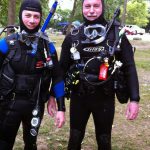Your new scuba student has practiced descents in a confined water pool. Perhaps the pool was 5.5 meters (18 feet) deep. Maybe it was 3.5 meters (12 feet) deep. Possibly it was just 2.5 meters (8 feet) deep.
Now it’s time for the open water dives!
Is your new aquanaut diving in a cold quarry outfitted in a full 7mm wetsuit complete with gloves, hood and a belt laced with 10 kilograms (22 pounds) of lead weight?
Or is the diver at a tropical island giant striding off of a boat into the salty sea with what seems like endless depth below and a feeling of smallness in a vast ocean?
That first plunge into the unknown can be disconcerting.
The environment, water conditions and diver’s psyche all play a part in the first open water encounter.

If a first descent is to be in a cold-water quarry, a diver should have previously experienced a neoprene hood’s constriction, the stuffed-sausage feeling of a wetsuit, and the restrictions of using gloves in confined water.
If a first descent is in the tropics and the diver has never been on a boat before, it would be of benefit to have the opportunity to go on a “test boat drive.” And even if your new diver has been on a boat before, there is a benefit and familiarization from watching other divers prepare, stride and submerge into the sea.
Whether at a quarry or in the tropics, new divers experience feelings and thoughts they’ve never before had — feelings and thoughts that can be quite unnerving.
Some new divers will become totally preoccupied with thinking, “I’ve never done this before in water this deep. Will my ears clear? Will my weight belt fall off? Will I sink to the bottom? Can I control my descent? Will I remember my training? Will I lose my buddy? Will this regulator really work at these depths?”
There’s nothing in life that quite compares to having one’s head immerse in water to the point of looking upward only to see more water.
The diver’s experiences on that first dive are vivid. The memories are lasting.
A negative first experience can be dissuading. A positive experience can launch a life of diving.
Preparation is important. Discussions and question and answer sessions about what descending in open water might be like, look like and feel like are extremely helpful.
The day of a diver’s first descent is greatly assisted by favorable dive conditions, both topside and below. A calm, warm day above the waves sets the stage for success underwater.
Reminding students on land or boat to equalize their ears before the water entry and to clear early and often will prepare them to stay ahead of a potential problem.
And before that first giant leap, a diver can be supported and bolstered by having not only the buddy, but also the instructor perform the pre-dive check. Being reassured of readiness by an instructor’s “looks good to go” can boost confidence and ease anxieties.
Once in the water, remind your divers that descending together as a buddy team is essential for safety.
After all the preparation and training, the discussions, and the questions and answers, how is the new diver going to react?
What else can an instructor look for and do to assist a new diver on that first descent in open water?
An instructor is not a mind reader. You cannot actually feel what the new diver feels, but you should know what to look for. You can see and notice the actions and inactions of your diver’s first descent in open water.
The diver may be feeling fine, or on the other hand, may appear stuck on the surface waiting for courage. If this happens, you can be encouraging by modeling inflation and deflation of the BC inflator.
A diver may be feeling apprehensive, and this may be shown by hesitant or somewhat frozen movements. If you see this, you can strengthen a diver by recalling the successes and competency demonstrated in water skills classes.
A diver’s discomfort may be shown by fumbling with equipment. In this instance, an instructor can model and direct the diver to locate and properly use the equipment.
The anxious diver may stare at and move toward the instructor for comfort or help. When this happens, you can coach and make reassuring physical contact with the diver at arm’s length.

Then there are some divers who may begin to feel panicky and start to act erratically. That is when an instructor can take command and calmly attempt to regulate the diver’s actions through a guided routine of slower breathing, slower movement and thinking before acting.
The vast majority of the time, a new diver’s first descent in open water is performed safely and perfectly with results that are exhilarating and exciting.
But for some, that first plunge is a drop into the depths with startling feelings and thoughts that they’ve never before experienced.
For these divers, their feelings and thoughts can be supported and buoyed by an instructor who can see by the diver’s actions, what the diver is experiencing and who remembers what their own first time felt like.
They can help ensure the new diver’s first open water descent will be a positive event — a positive event that they will never forget!


